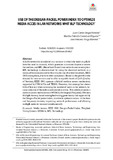Use of the Deegan-Packel power index to optimize media acces in LAN networks whit BLP technology
Uso del índice de poder Deegan-Packel para la optimización de acceso al medio en redes LAN con tecnologías BPL
Compartir este ítem
Fecha
2022-01-31Autor
Vesga Ferreira, Juan Carlos
Contreras Higuera, Martha Fabiola
Vesga Barrera, José Antonio
Citación
Metadatos
Mostrar el registro completo del ítemDocumentos PDF
Resumen
A LAN network is considered as a scenario in which the nodes regularly have the need to transmit, which generates a constant dispute to Access the medium, and BPL (Broadband Power Line) networks are no exception. BPL technology is characterized by using the electrical network as a means of transmission and for this it makes use of several standards, IEEE 1901 among them, due to its wide acceptance. Based on the growth in the demand for new services and to offer acceptable levels of QoS (Quality of Service), IEEE 1901 operates a hybrid medium access mechanism, supported by CSMA/CA and TDMA. However, this strategy has shown little efficiency when increasing the number of nodes in the network, because only one of the nodes can transmit at a time. This article proposes a medium access mechanism on OFDMA (Orthogonal Frequency-Division Multiple Access), based on weighted voting game theory and supported by the Deegan-Packel power index, in order to optimize access. in the time and frequency domain, improving network performance and allowing multiple nodes to transmit simultaneously. Una red LAN es considerada como un escenario en el cual los nodos tienen la necesidad recurrente de transmitir, lo cual genera una disputa constante ara acceder al medio, y las redes BPL (Broadband Power Line) no son una excepción. La tecnología BPL se caracteriza usar las redes energéticas como medios de transmisión y para esto usa varios estándares, estando el IEEE 1901 entre ellos, debido a su amplia aceptación, Basados en el crecimiento de la demanda de estos nuevos servicios y para ofrecer niveles aceptables de QoS (Calidad del Servicio en sus siglas en inglés), el IEEE 1901 opera un mecanismo híbrido de acceso al medio soportado por CSMA/CA y TDMA. Sin embargo, esta estrategia ha mostrado muy poca eficiencia al incrementarse el número de nodos en la red, ya que solo puede haber un nodo transmitiendo al mismo tiempo. Este artículo propone un mecanismo de acceso al medio en OFDMA (Orthogonal Frequency-Division Multiple Access), basado en juegos de votación ponderada y soportado por el índice de poder Deegan-Packel con el fin de optimizar el acceso en el tiempo y frecuencia del dominio, mejorando así el desempeño de la red y permitiendo que múltiples nodos transmitan simultáneamente.


